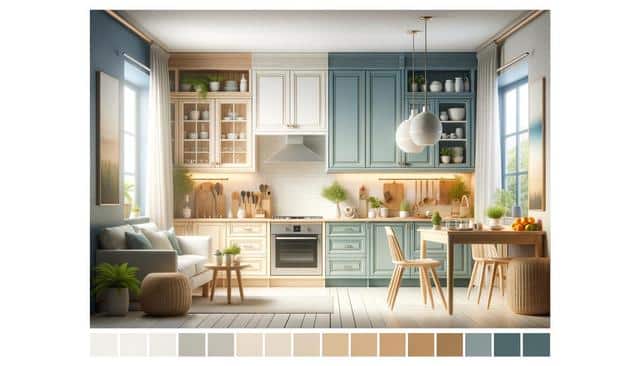Kitchen Cabinet Colors: What’s Trending and What’s Fading Away
Popular kitchen cabinet colors include white, gray, and navy, which provide a sleek and modern look. Outdated colors, such as avocado green and mustard yellow, have fallen out of favor, with homeowners shifting toward more neutral, timeless shades.

The Rise of Neutral and Elegant Tones
Neutral colors have gained widespread popularity in kitchen design due to their versatility and timeless appeal. Shades like white, beige, and light gray have become go-to choices for homeowners who want a clean and sophisticated look. These tones work well with a variety of countertop materials, backsplashes, and flooring options, making them an easy fit for many kitchen styles.
Light neutrals are especially effective in smaller kitchens, where they can brighten the space and make it appear larger. In open-concept homes, neutral cabinets help create a cohesive flow between the kitchen and adjoining living areas. Homeowners also appreciate the flexibility of neutral cabinets when it comes to decorating, as they serve as a blank canvas for seasonal accents or bold hardware choices.
Some of the most commonly used neutral cabinet colors include:
- Soft white
- Warm taupe
- Pale gray
- Greige (a mix of gray and beige)
These hues are not only stylish but also add long-term value to a kitchen, as they are less likely to go out of fashion quickly.
Bold Yet Balanced: Darker Cabinet Choices
While neutral tones dominate many kitchens, darker cabinet colors are also making a strong appearance. Navy blue, charcoal gray, and forest green are among the deeper shades that are trending in modern kitchen designs. These colors bring a sense of depth and sophistication, especially when paired with lighter countertops or metallic accents such as brass or gold.
Dark cabinets are often used as statement pieces, either for an entire kitchen or as part of a two-tone cabinet design. For example, many homeowners opt for darker lower cabinets while keeping the upper cabinets light to create visual balance. This approach adds dimension without overwhelming the space.
Some advantages of darker kitchen cabinets include:
- The ability to hide stains or fingerprints better than lighter colors
- A luxurious and elegant appearance
- Compatibility with a range of materials, such as wood, marble, and stone
However, it’s important to ensure that the kitchen has adequate natural or artificial lighting, as dark colors can make a space feel smaller if not balanced properly.
Colors That Have Lost Their Spark
As kitchen trends evolve, certain cabinet colors that were once fashionable have now become outdated. Colors such as avocado green, mustard yellow, and bright orange were popular in the 1960s and 1970s, reflecting the bold and experimental design trends of those decades. Today, these colors are often viewed as dated and can make a kitchen feel disconnected from current aesthetics.
Other once-popular but now fading cabinet colors include:
- Cherry red
- Chocolate brown with heavy red undertones
- Pastel pink or baby blue
These shades may still have a place in retro-inspired designs, but they are no longer seen as mainstream choices. Homeowners looking to increase the resale value of their property often steer clear of these colors, opting instead for tones that appeal to a broader audience.
If you’re renovating an older kitchen, updating cabinets with more neutral or contemporary colors can make a significant difference in the overall perception of the space.
Two-Tone Cabinets and Color Pairing Trends
One of the more creative trends in kitchen design is the use of two-tone cabinets. This involves pairing two complementary colors—often a light and a dark shade—to add contrast and dimension to the kitchen. This design choice allows homeowners to enjoy the benefits of both bold and neutral colors without committing to a single palette.
Popular two-tone combinations include:
- White upper cabinets with navy lower cabinets
- Light gray uppers paired with charcoal lowers
- Soft cream cabinetry with muted green accents
Two-tone cabinets are also a practical choice for breaking up large blocks of color, especially in kitchens with a lot of cabinetry. They can make the space more visually appealing and give it a custom-designed feel. When done thoughtfully, this approach adds a layer of sophistication and helps highlight architectural features like kitchen islands or built-in shelving.
Color pairing also extends to hardware and fixtures. For instance, warm metallics like gold or copper are often used with navy or forest green cabinets, while cooler tones like brushed nickel or chrome complement gray and white cabinetry.
Tips for Choosing the Right Cabinet Color
Selecting the right color for your kitchen cabinets involves more than following trends. It’s important to consider the overall style of your home, the amount of natural light in your kitchen, and your personal preferences. A well-chosen cabinet color can enhance the kitchen’s functionality and appeal for years to come.
Here are some tips to guide your decision:
- Evaluate your kitchen’s lighting—lighter colors work well in dimly lit spaces.
- Think about the long-term—neutral tones are more likely to remain stylish over time.
- Consider your countertops and flooring—choose a cabinet color that complements these elements.
- Test paint samples—view them at different times of day to see how lighting affects the color.
Ultimately, your kitchen should reflect your lifestyle and taste. Whether you’re leaning toward a modern monochrome palette or experimenting with bold contrasts, the key is to create a space that feels inviting and cohesive.
Conclusion: Creating a Timeless Kitchen with Smart Color Choices
Choosing the right color for your kitchen cabinets is one of the most impactful decisions you can make in a kitchen remodel or design. While trends come and go, opting for neutral shades like white, gray, and navy allows for flexibility and long-term appeal. At the same time, incorporating darker or contrasting tones can add personality and depth when used thoughtfully. By avoiding outdated colors and focusing on balanced, timeless palettes, homeowners can create a kitchen that remains stylish and functional for years to come.